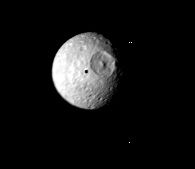|
----------------- a work of fiction Jupiter moons ----------------- to Galileo |
|
|
|
|
|
||
|
----------------- a work of fiction Jupiter moons ----------------- to Galileo |
|
|
The exact rotation period of Saturn is still unclear. Its surface markings are faint and smeared out along lines of longitude, so unlike Jupiter, it was hard to determine a rotation period. Before the first planetary probe encounters, that period was estimated by other means to be about 10 hours and 15 minutes. This may change as a result of a giant long lived storm observed on Saturn from December 2010, lasting many months (Feb. 2011 images, here).
Planetary probes observed the rotation periods of sources of radio emissions, believed to rotate with a magnetic field rooted in the planet. Voyager observations around 1980 gave 10 hrs., 39 minutes, those of "Cassini" in 2004, 10 hours and 45 minutes. If Saturn's magnetic axis were inclined to its rotation axis (as it is for Jupiter--about 9.6 degrees) we would observe a "wobble" in the direction of the observed equatorial field, with the period of rotation. However any inclination of Saturn's magnetic axis seems to be too small to observe, so this method can't be used. Saturn has 34 named moons, among them Titan, about the size of Jupiter's Ganymede, both larger than the planet Mercury. Because of the distance from the Sun about (10 time greater than Earth's), Titan is extremely cold and has "oceans" of liquid methane, mapped by the space probe Huygens which landed there on January 14, 2005, as part of the European Cassini mission.  Other moons include small Mimas, some 500 km across, just about as small as a spherical satellites get. Its one notable feature is its giant crater "Herschel," which rarely fails to remind observers (at least, those who have seen "Star Wars") of the "Death Star" in that film. And then there is Iapetus, with strange surface markings--half of it covered with some very dark material. In Arthur Clarke's novel and film "2001--a Space Odyssey", Iapetus is the target of a spaceship sent from Earth to trace the source of a mysterious signal, associated with a black monolith found on our Moon. It finds there the gateway to a strange, mysterious part of the universe, which the film at least never explains.
Other moons include small Mimas, some 500 km across, just about as small as a spherical satellites get. Its one notable feature is its giant crater "Herschel," which rarely fails to remind observers (at least, those who have seen "Star Wars") of the "Death Star" in that film. And then there is Iapetus, with strange surface markings--half of it covered with some very dark material. In Arthur Clarke's novel and film "2001--a Space Odyssey", Iapetus is the target of a spaceship sent from Earth to trace the source of a mysterious signal, associated with a black monolith found on our Moon. It finds there the gateway to a strange, mysterious part of the universe, which the film at least never explains.
Saturn's RingsIn 1655 the correct explanation was given by Christiaan Huygens, a Dutch scientist who is also credited with discovering Titan, the wave theory of light, pendulum clocks and more. His correct interpretation ("a thin flat ring nowhere touching and inclined to the ecliptic") was not made public at first--instead Huygens teased astronomers to match his conclusion, by releasing an anagram of the above statement (in Latin). No one managed to solve it. If the ring were solid, its parts at different distances would try to orbit at different speeds (Kepler's 3rd law) and would quickly tear it apart. Instead, the rings seem to consist of small icy rocks, each orbiting at its own period. Where these orbits "resonate" with the motion of a moon, strong interactions occur, creating empty gaps. Most famous is the wide Cassini division, discovered in 1675 by Giovanni Domenico Cassini, head of the Paris observatory and founder of a dynasty of astronomers Because of this, the European-NASA mission to Saturn, launched 1997 and arriving at the planet in July 2004, was named "Cassini", while the probe launched from it on Christmas 2004 to hit the moon Titan was named Huygens, after the moon's discoverer. Why rings? Imagine an orbiting moon made of a (non-evaporating) liquid. Two forces act on it. The gravity of the central body tends to make it all orbit at a single period corresponding to its center of mass (or center of gravity), while the gravity gradient tends to pull it apart, with parts closer to the center orbiting faster. The moon's own gravity counteracts such break-up: at the edge closest to the central planet, it weakens the pull in that direction, while at the edge most distant, where the gravity controlling the orbit is weakest, it tends to bolster it. Can this prevent break-up? Edouard Roche, a French astronomer, showed in 1848 that the answer depended on the distance from the center of attraction (also the density of the fluid). Within the "Roche Limit" the mass will break apart, while at greater distances, stable rotation is possible. Gravity on a celestial scale can be pretty powerful, so large solid moons are not likely to be found inside the Roche Limit of a planet. The outermost edge of Saturn's rings is indeed close to the Roche limit. Small moons (50 km or less) were observed inside the rings (modifying their structure), but over such small distances, solid cohesion apparently still prevails over the gravity gradient. |
Next Subject: #P-10 The Telescope
Next Stop (following "The Planets"): #9c The Discovery of the Solar System, from Copernicus to Galileo
Timeline Glossary Back to the Master List
Author and Curator: Dr. David P. Stern
Mail to Dr.Stern: stargaze("at" symbol)phy6.org .
Last updated: 17 June 2011